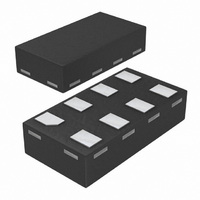LM75BGD,125 NXP Semiconductors, LM75BGD,125 Datasheet - Page 24

LM75BGD,125
Manufacturer Part Number
LM75BGD,125
Description
IC TEMP SENSOR DGTL 8-UXSON
Manufacturer
NXP Semiconductors
Datasheet
1.LM75BDP118.pdf
(29 pages)
Specifications of LM75BGD,125
Package / Case
8-XSON
Function
Temp Sensor, Watchdog
Topology
ADC (Sigma Delta), Comparator, Oscillator, Register Bank
Sensor Type
Internal
Sensing Temperature
-55°C ~ 125°C
Output Type
I²C™
Output Alarm
No
Output Fan
Yes
Voltage - Supply
2.8 V ~ 5.5 V
Operating Temperature
-55°C ~ 125°C
Mounting Type
Surface Mount
Temperature Threshold
+ 80 C
Full Temp Accuracy
+/- 3 C
Digital Output - Bus Interface
I2C
Digital Output - Number Of Bits
11
Supply Voltage (max)
5.5 V
Supply Voltage (min)
2.8 V
Maximum Operating Temperature
+ 125 C
Minimum Operating Temperature
- 55 C
Supply Current
100 uA
Temperature Sensor Function
Temp Sensor
Operating Temperature (max)
125C
Operating Temperature Classification
Military
Operating Supply Voltage (typ)
3.3/5V
Operating Supply Voltage (max)
5.5V
Lead Free Status / RoHS Status
Lead free / RoHS Compliant
Lead Free Status / RoHS Status
Lead free / RoHS Compliant, Lead free / RoHS Compliant
Other names
568-4769-2
935288239125
935288239125
Available stocks
Company
Part Number
Manufacturer
Quantity
Price
Company:
Part Number:
LM75BGD,125
Manufacturer:
NXP
Quantity:
6 180
NXP Semiconductors
14. Soldering of SMD packages
LM75B_2
Product data sheet
14.1 Introduction to soldering
14.2 Wave and reflow soldering
14.3 Wave soldering
This text provides a very brief insight into a complex technology. A more in-depth account
of soldering ICs can be found in Application Note AN10365 “Surface mount reflow
soldering description” .
Soldering is one of the most common methods through which packages are attached to
Printed Circuit Boards (PCBs), to form electrical circuits. The soldered joint provides both
the mechanical and the electrical connection. There is no single soldering method that is
ideal for all IC packages. Wave soldering is often preferred when through-hole and
Surface Mount Devices (SMDs) are mixed on one printed wiring board; however, it is not
suitable for fine pitch SMDs. Reflow soldering is ideal for the small pitches and high
densities that come with increased miniaturization.
Wave soldering is a joining technology in which the joints are made by solder coming from
a standing wave of liquid solder. The wave soldering process is suitable for the following:
Not all SMDs can be wave soldered. Packages with solder balls, and some leadless
packages which have solder lands underneath the body, cannot be wave soldered. Also,
leaded SMDs with leads having a pitch smaller than ~0.6 mm cannot be wave soldered,
due to an increased probability of bridging.
The reflow soldering process involves applying solder paste to a board, followed by
component placement and exposure to a temperature profile. Leaded packages,
packages with solder balls, and leadless packages are all reflow solderable.
Key characteristics in both wave and reflow soldering are:
Key characteristics in wave soldering are:
•
•
•
•
•
•
•
•
•
•
Through-hole components
Leaded or leadless SMDs, which are glued to the surface of the printed circuit board
Board specifications, including the board finish, solder masks and vias
Package footprints, including solder thieves and orientation
The moisture sensitivity level of the packages
Package placement
Inspection and repair
Lead-free soldering versus SnPb soldering
Process issues, such as application of adhesive and flux, clinching of leads, board
transport, the solder wave parameters, and the time during which components are
exposed to the wave
Solder bath specifications, including temperature and impurities
Rev. 02 — 9 December 2008
Digital temperature sensor and thermal watchdog
© NXP B.V. 2008. All rights reserved.
LM75B
24 of 29














